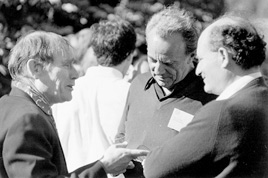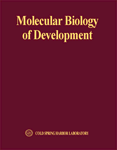|
L: Molecular Biology of Development 1985 |
|
|

|
From left: Dr. Sydney Brenner, Dr. Francois Jacob, Dr. Seymour Benzer SYMPOSIUM SYNOPSIS LIST OF PARTICIPANTS CONTENTS OF SYMPOSIUM VOLUME PHOTOGRAPHS PUBLISHED VOLUME  |
Molecular Biology of Development
1985
Symposium Synopsis
Organizer: Joe Sambrook
Advisors: John Gurdon, Gerry Rubin, Sydney Brenner, David Ish-Horowicz, Doug Hanahan, Don Brown, Paul Bingham, Tom Maniatis and Paul Wassarman
It is remarkable that embryology—a "hot" field at the turn of the 19th century—never became a topic research at Cold Spring Harbor. It was not that Charles Davenport was unaware of embryology. In 1896, as an instructor at Harvard, he introduced a new course on "Experimental Morphology" and taught it for six years. He published a book with that title and did research on the water content of frog's eggs during development. But Davenport instead took up the new science of genetics and the Biological Laboratory never came to be a rival of the Woods Hole Biological Laboratory or the Stazione Zoologica at Naples.
Genetics continued to be the central theme of research at Cold Spring Harbor and there was little chance that embryology would be added, given the notorious separation between the two disciplines for most of the 20th century. A biochemical embryology did develop, but this was largely measuring and cataloging changing quantities of chemicals during development, an approach typified by Joseph Needham's epic three-volume Chemical Embryology. Not withstanding the early work of scientists like Richard Goldschmidt, Conrad Waddington, Boris Ephrussi and Jean Brachet, a genetic and molecular biological approach to development was hardly possible until the 1970s. Then molecular tools began to be combined with genetic analysis, exemplified by the work of Ed Lewis, Christiane Nusslein-Volhard and Eric Wieschaus on Drosophila development.
This led to extraordinary advances in understanding development, and to the remarkable research reported at the 50th Symposium, held to celebrate the new developmental biology. There was hardly a title that did not include the word "gene" and there was an extraordinarily wide range of organisms studied. The homeotic and segmentation genes of Drosophila took central stage but papers on transgenic mice and embryonic stem cells pointed to the future.
Demerec had been premature in 1956 when he had remarked that "Recent developments...indicate that we may be on the verge of bridging the gap that now separates genetics and embryology". So, it was fitting that 50th Symposium celebrated the true completion of that bridge. That embryology had become of age was evident in the awarding of the 1995 Nobel Prize to Lewis, Nusslein-Volhard and Wieschaus—the first Prize in this field since the 1935 award to Hans Spemann.
Search images: